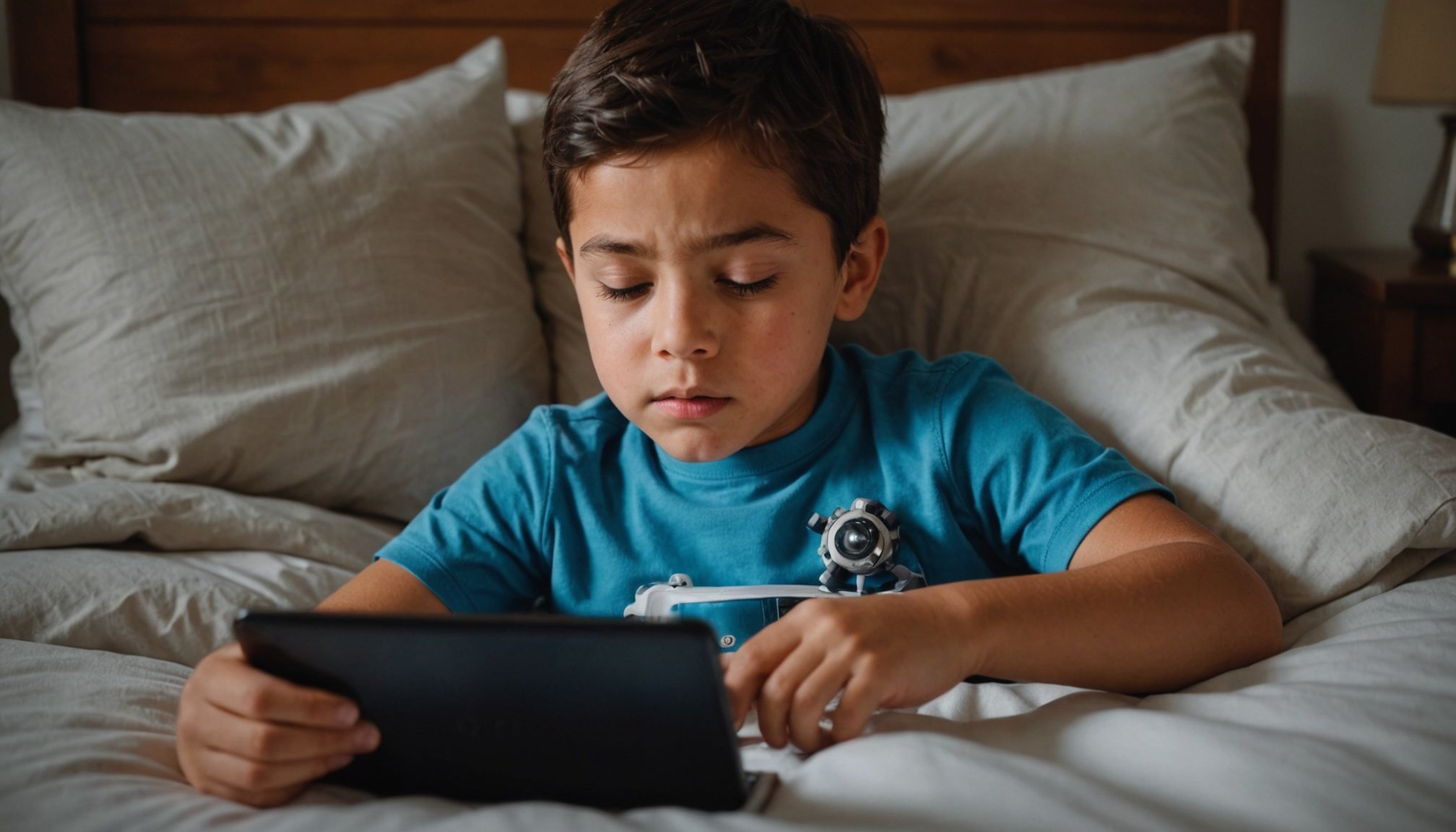Impact of Screen Time on Sleep Patterns
The relationship between screen time effects and sleep disruption in children has been extensively studied. Research consistently links excessive screen use to poor sleep quality, attributing disruptions primarily to the blue light emitted by devices. This type of light is known to interfere with the production of melatonin, a hormone crucial for regulating sleep-wake cycles.
Children, with their rapidly developing brains, are particularly vulnerable to these screen time effects. Studies reveal that increased exposure correlates with increased difficulty in falling asleep, reduced sleep duration, and decreased overall sleep quality. Notably, the presence of screens in bedrooms further exacerbates these issues, creating lasting impacts on health and academic performance.
Also to read : Exploring the Potential of a Polyphenol-Rich Diet to Halt Parkinson”s Disease Progression
To mitigate these effects, experts recommend limiting children’s screen use in the hours leading up to bedtime. Engaging in non-screen related activities, such as reading or puzzles, is encouraged as a calming alternative. It’s also advisable to establish a consistent bedtime routine to help ease the transition from screen time effects to restful sleep. By implementing these strategies, the adverse effects on sleep patterns can be significantly reduced, promoting better rest and overall wellbeing.
Mental Health Consequences of Prolonged Screen Exposure
Prolonged exposure to screens has been linked to various mental health effects, particularly in children. Studies indicate a worrying rise in both anxiety and depression rates, frequently correlating with increased screen time. This connection is especially relevant in the context of childhood anxiety, where excessive use of digital devices often heightens stress levels and diminishes overall emotional health.
Also to read : Unlocking Cavity Prevention in Kids: The Advantages of Silver Diamine Fluoride in Pediatric Dentistry
Furthermore, there’s a growing concern over screen addiction. This phenomenon doesn’t only increase risks of mental health issues but can also affect cognitive development and social skills. Children addicted to screens may struggle with attention and impulse control, often displaying symptoms akin to other kinds of addictive behaviours.
Balancing screen use with offline activities remains crucial for healthy mental development. Encouraging children to engage in physical activities or hobbies that do not involve screens can help mitigate these adverse mental health effects. Parents and educators should strive to set boundaries and offer alternative engaging activities, ensuring that screen time does not overwhelmingly dominate a child’s daily routine. This holistic approach supports not only mental but also social and physical wellbeing, fostering healthier development during childhood.
Age-Specific Considerations for Screen Time
Understanding the age screen time recommendations is crucial for ensuring that digital media use is beneficial rather than detrimental to children’s growth. The guidelines vary significantly across different age groups, highlighting the developmental impact screens may have. For instance, infants under 18 months should avoid screens except for video chatting. As children grow, recommendations become less restrictive. Preschoolers, aged 2 to 5 years, can have up to one hour of high-quality programming daily, aiding in educational development if guided properly.
Screen exposure effects differ widely between younger and older children. Young children might experience delays in language and social skills if screens replace interactive play and conversation. Meanwhile, older children may struggle with decreased academic performance and reduced physical activity when screen use becomes excessive.
Parents can employ various strategies to ensure age-appropriate screen use. Consider setting time limits consistent with developmental impact guidelines, and encourage activities that use technology for learning rather than entertainment alone. It’s also helpful to engage with children during their screen time by asking questions about what they see or learn. Monitoring content and modeling balanced screen habits can aid in fostering a healthy digital environment.
Practical Tips for Managing Screen Time
Creating healthy screen habits at home is crucial for both children and adults. Begin by setting clear boundaries for usage, such as designated device-free times or areas. This can involve having no screens during meals or in bedrooms. Encourage alternative activities like reading, outdoor play, or family board games to naturally reduce reliance on screens.
Implementing effective screen time management strategies involves a mix of routine and flexibility. Develop a consistent schedule that incorporates enough breaks to prevent digital fatigue. Involving the family in designing this schedule can ensure it is practical and respected by all members.
Parental guidance plays a pivotal role. Children often mimic behaviours they observe, so if parents actively reduce their own screen usage and engage in other activities, children will likely follow suit. By modelling balanced screen habits, parents can instil values that promote healthier screen usage for the whole family. Reinforcing these behaviours through positive reinforcement can further support this transition.
Finally, maintain open discussions with family members about the impacts of excessive screen time. Understanding the ‘why’ behind restrictions helps build a cooperative environment tailored to each individual’s needs. Through these strategies, households can enjoy digital content in moderation, enhancing overall well-being.
Expert Opinions and Research Insights
Navigating the complexities of children’s screen time can be challenging, but expert advice offers guidance. Specialists agree on the importance of moderating digital consumption for children’s development. Research studies highlight potential cognitive and behavioural effects when limits aren’t structured. Data analysis consistently shows that excessive screen use can impede physical activity, affect sleep patterns, and delay social skills development.
From this perspective, it’s crucial to create a balanced digital diet. Experts suggest setting specific usage periods to ensure diverse activities remain part of children’s daily routines. Such strategies foster a healthier relationship with technology.
Insights from leading research studies, such as those by the American Academy of Pediatrics, actively inform these guidelines. Their findings caution against passive screen use, particularly in early childhood. Instead, they advocate for educational content co-viewed with parents. This ensures that children remain engaged rather than passively consuming content.
The evolving nature of technology further complicates policy-making. With each new device, understanding shifts, necessitating continuous updates to screen time recommendations. However, the underlying principle remains: informed, mindful practice supports better outcomes for children across various developmental stages.











